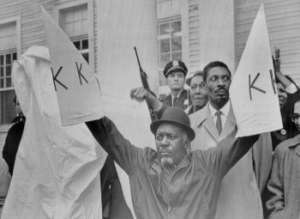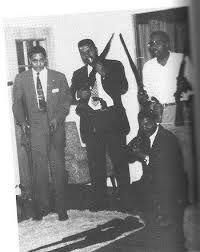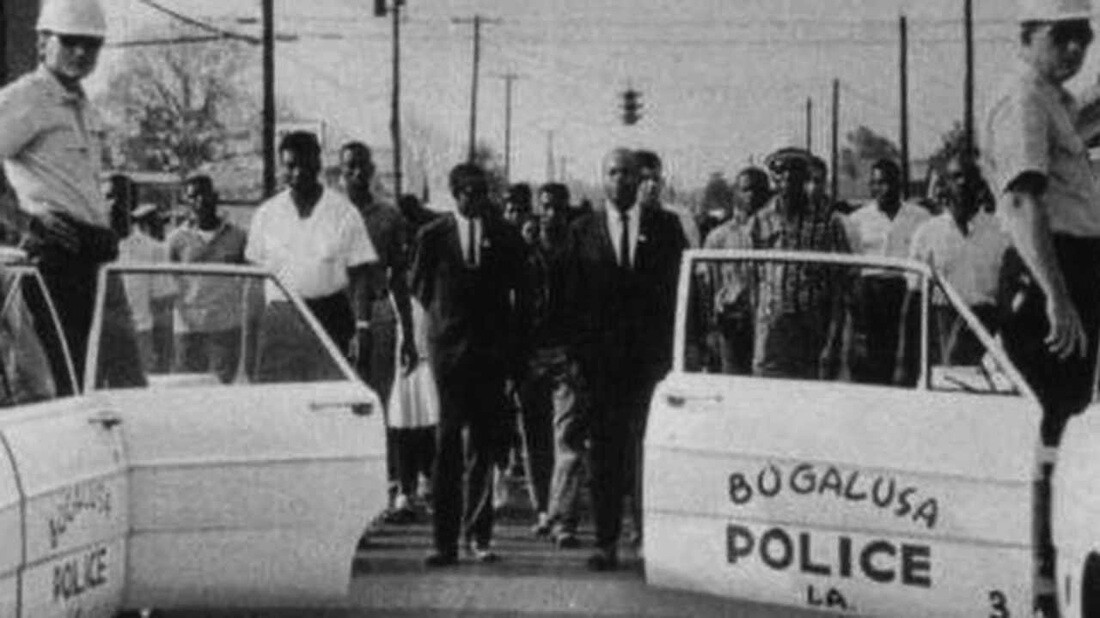How Firearms were used to Protect Community Voting Rights in the 60’s

On July 10, 1964, a group of African American men in Jonesboro, Louisiana led by Earnest “Chilly Willy” Thomas and Frederick Douglas Kirkpatrick founded the group known as “The Deacons for Defense and Justice to protect members of the Congress of Racial Equality (CORE) against Ku Klux Klan violence. Born in Jonesboro on November 20, 1935, Thomas grew up in the segregated state decades after the white-dominated state legislature had disenfranchised most blacks at the turn of the century and imposed Jim Crow laws. Following his military service during World War II, Thomas came to believe that political reforms had to be secured by force rather than moral appeal.
In 1964, during Freedom Summer and a period of extensive voter education and organizing for registration, especially in Mississippi, the Congress of Racial Equality established a Freedom House in Jonesboro. It became a target of the Klan who resented white activists staying there. Because of repeated attacks on the Freedom House, as well as the church burnings, the Black community decided to organize to defend it. Before The Deacons of Defense and Justice officially formed, two groups were operating in Jonesboro to protect African Americans. One group acted as sentries outside the Freedom House. This group was led by Percy Lee Bradford, a stockroom worker, and Earnest Thomas. Fredrick Douglas Kirkpatrick, a high school teacher, organized a second group that volunteered to monitor police arrests of African Americans while also working to keep the community safe. Thomas was one of the first volunteers to guard the house. According to historian Lance Hill, “Thomas was eager to work with CORE, but he had reservations about the nonviolent terms imposed by the young activists. Around this time, CORE began protesting the segregation of a public swimming pool as well as the Jonesboro Public Library. In response to the protest, the Ku Klux Klan and local police organized a caravan to intimidate the protesters and the African American community in Jonesboro. Thomas and Kirkpatrick organized a twenty men group to protect the citizens of Jonesboro, effectively starting the Deacons.

Thomas, who had military training, quickly emerged as the leader of this budding defense organization. He was joined by Frederick Douglass Kirkpatrick, a civil rights activist and member of SCLC, who had been ordained that year as a minister in the Pentecostal Church of God in Christ. Coretta Jackson acted as treasurer for The Deacons Of Defense and Justice. We had been arrested for possession of a concealed weapon while protecting protesting students. The Deacons had strict membership criteria for applicants. They accepted only male American citizens over the age of 21.
They preferred married men with military service, as well as registered voters. They refused men with a reputation for “hotheadedness. They vigorously upheld their stance of only acting in defense. They continued guarding CORE as a means to further the overall civil rights agenda. Every member of the Deacons had to pledge his life for the defense of justice, black people, and for civil rights workers.
During the day, the men concealed their guns. At night they carried them openly, as was allowed by the law, to discourage Klan activity at the site and in the black community. In early 1965, Black students were picketing the local high school in Jonesboro for integration. They were confronted by hostile police ready to use fire trucks with hoses against them. A car carrying four Deacons arrived. In view of the police, these men loaded their shotguns. The police ordered the fire truck to withdraw. This was the first time in the 20th century, as Hill observes, that “an armed black organization had successfully used weapons to defend a lawful protest against an attack by law enforcement.”
Hill also wrote: “In Jonesboro, the Deacons made history when they compelled Louisiana governor John McKeithen to intervene in the city’s civil rights crisis and require a compromise with city leaders — the first capitulation to the civil rights movement by a Deep South governor.
After traveling 300 miles to Bogalusa, in southeast Louisiana, on February 21, 1965, Kirkpatrick, Thomas and a CORE member worked with local leaders to organize the first affiliated Deacons chapter. Black activists in the company mill town were being attacked by the local and powerful Ku Klux Klan. The police and sheriff in Bogalusa, as well as most government organizations, were all infiltrated by the Klan. As a result, the only protection the people of Bogalusa had against the Klan was the Deacons. Although the Civil Rights Act of 1964 had been passed, blacks were making little progress toward the integration of public facilities in the city or registering to vote. Activists Bob Hicks (1929-2010), Charles Sims, and A. Z. Young, workers at the Crown-Zellerbach plant (Georgia-Pacific after 1985, later acquired by another), led this new chapter of the Deacons for Defense. Charles Sims, a World War II veteran was the president of the Bogalusa chapter of the Deacons. He acted as spokesman for the Deacons, demanding fair treatment and threatening violent retaliation in the event of an attack. Sims considered the Deacons a “defense guard unit” who had formed simply because we got tired of black women, the children being harassed by the white night-riders.
The Chicago Chapter of the Deacons for Defense and Justice was formed by Ernest Thomas, vice president of the Jonesboro chapter, in 1965. The Deacons intended to spread throughout the North and the West but were ultimately unsuccessful because their tactics were less effective outside of the South.
In the summer of 1965, the Bogalusa chapter campaigned for integration and came into regular conflict with the Klan in the city. The state police established a base there in the spring in expectation of violence after the Deacons organized.[12] Before the summer, the first black deputy sheriff of the local Washington Parish was assassinated by whites.
The Deacons’ militant confrontation with the Klan in Bogalusa throughout the summer of 1965 was planned to gain federal government intervention. These tactics proved successful when “in July 1965, escalating hostilities between the Deacons and the Klan in Bogalusa provoked the federal government to use Reconstruction-era laws to order local police departments to protect civil rights workers. The Deacons also initiated a regional organizing campaign, found a total of 21 formal chapters and 46 affiliates in other cities Finally, the organization was relatively short-lived, fading by 1968. In that period, there was a national shift in attention to the issues of Blacks in the North and the rise of the Black Power movement in 1966.
The Deacons were overshadowed by The Black Panther Party, which became noted for its militancy.

